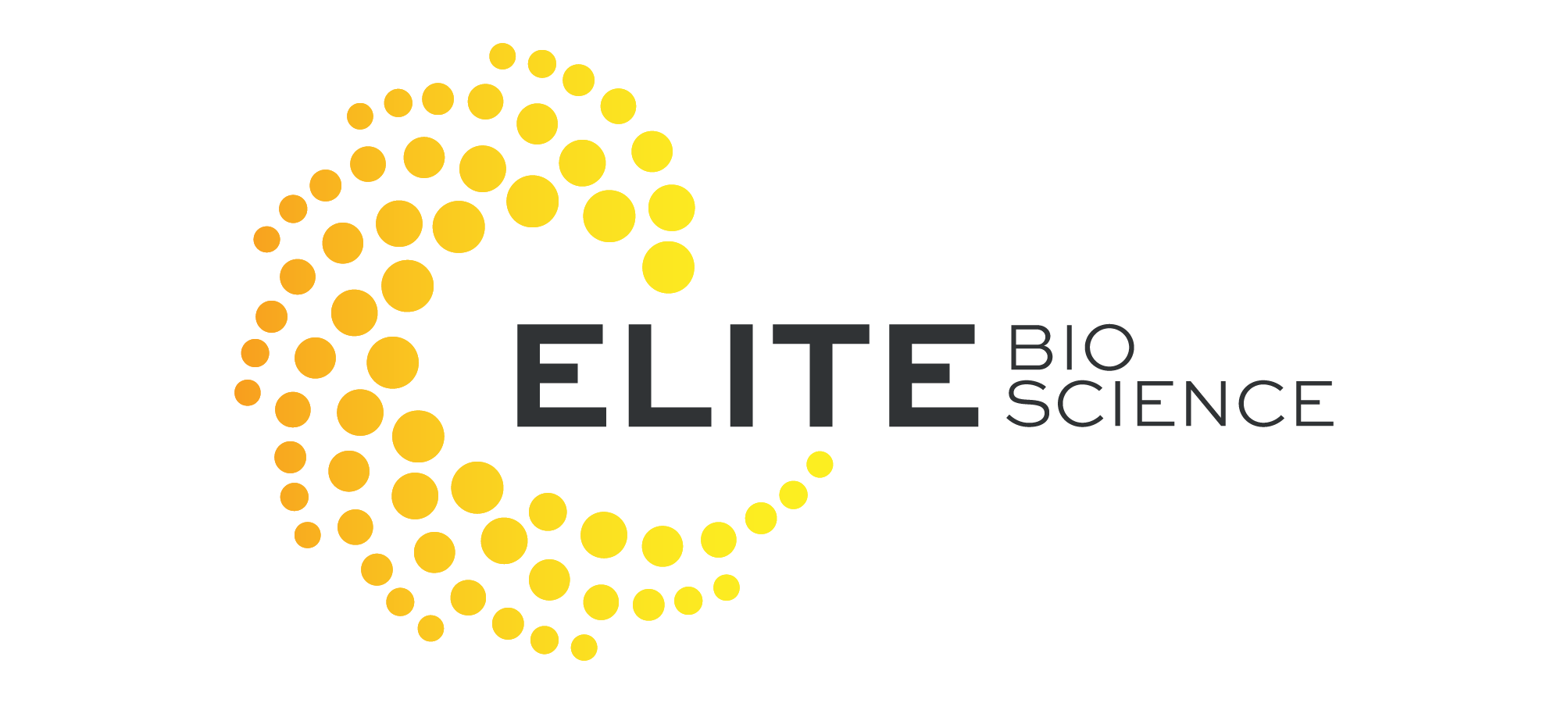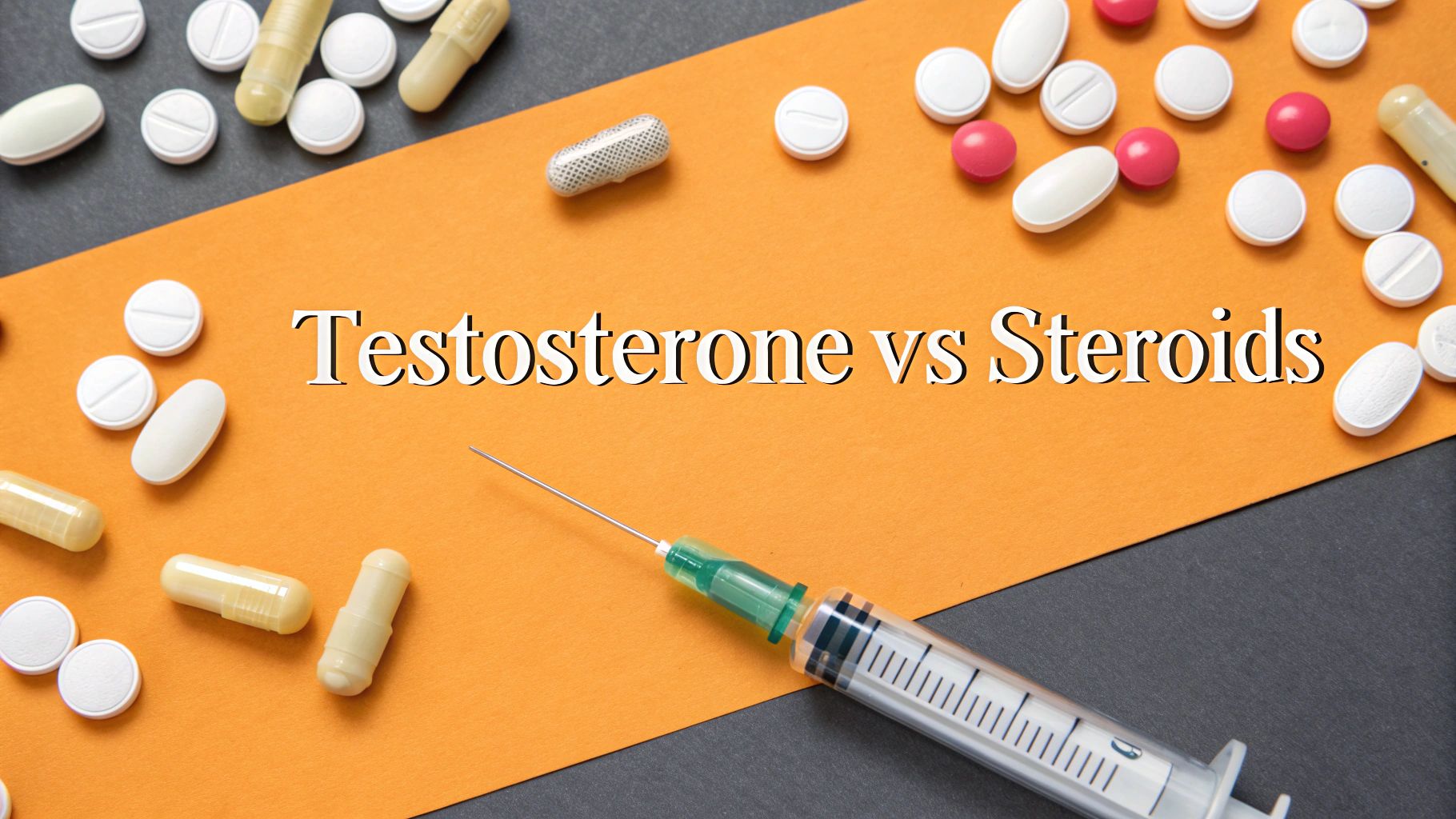When you first start looking into Testosterone Replacement Therapy (TRT), one of the biggest questions on your mind is probably, "What's this actually going to cost me?" The honest answer is that the price can vary—a lot. You'll see numbers anywhere from $150 to $1,500 a month if you're paying out-of-pocket.
That massive range isn't a typo. It's because TRT isn't a single product with one price tag. Instead, the final cost is a bundle of different services and medications. Your total investment really depends on your specific needs, the type of treatment you choose, your clinic's fee structure, and whether your insurance decides to play ball.
What Does Testosterone Replacement Therapy Really Cost?
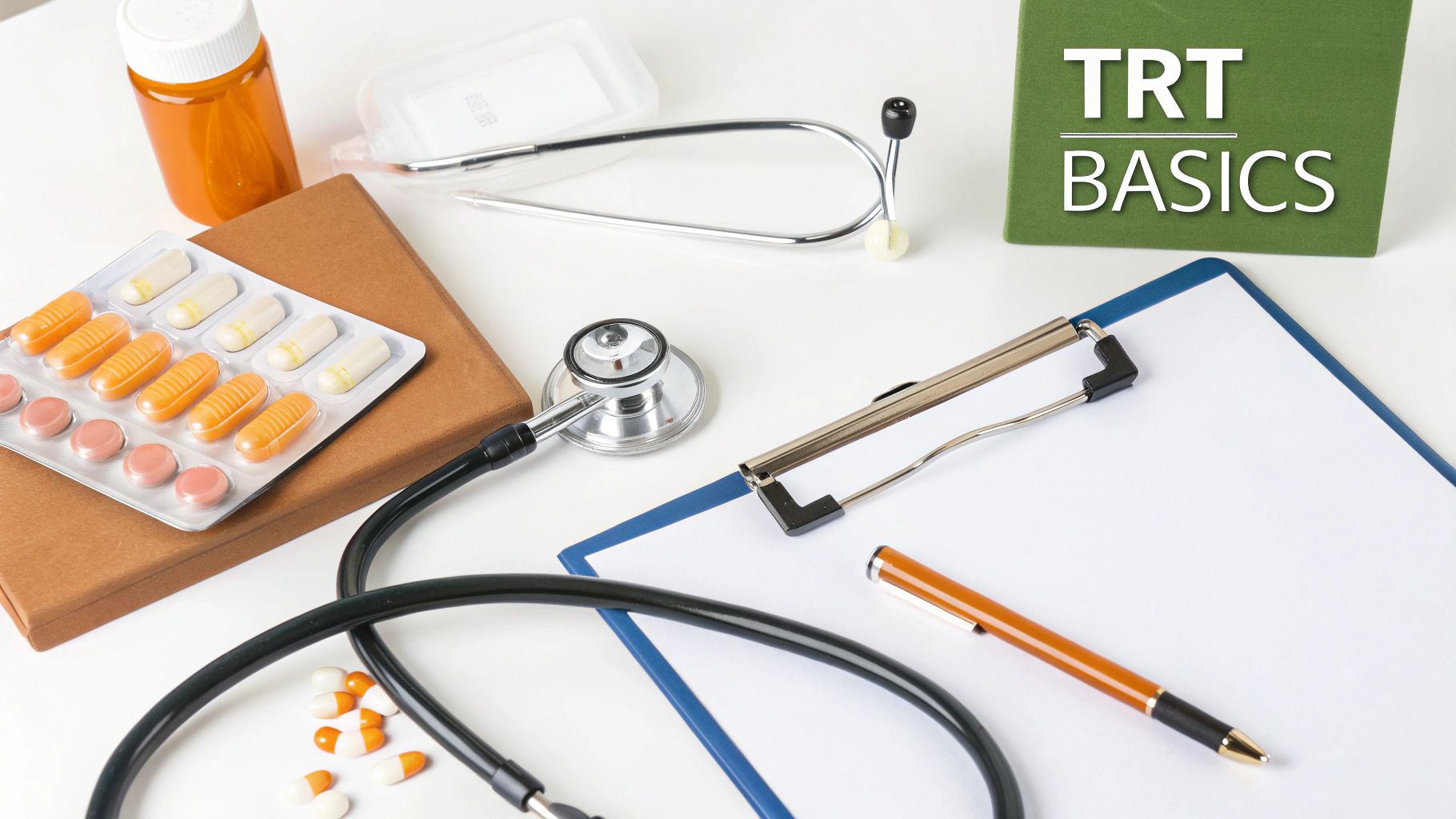
Trying to figure out the real cost of TRT can feel like assembling a puzzle without the picture on the box. The price isn't just for the testosterone itself; it’s for the entire system of care that ensures you get it safely and effectively. Think of it like buying a car: you’re not just paying for the engine. The price includes the chassis, the electronics, the safety features, and the expert assembly—all working together.
A proper TRT plan is built on a few core components, each with its own price. Before you even get your first dose, you have to confirm a diagnosis of low testosterone. That means an initial consultation with a medical professional and a full panel of lab work, which both have their own one-time costs right at the start.
A Quick Snapshot of TRT Expenses
To give you a clearer idea of where the money goes, it helps to break down the main expenses you can expect. The table below provides a general overview of what each part of a TRT program might cost. Just remember, these are typical ranges, and your individual plan could look different.
To help set expectations, here’s a look at what goes into the monthly cost of a TRT program.
Estimated Monthly Cost of TRT Components
| TRT Component | Typical Monthly Cost Range (Out-of-Pocket) |
|---|---|
| Testosterone Medication | $40 – $200+ |
| Lab Work (Ongoing) | $75 – $250 |
| Medical Consultations | $75 – $200 |
| Supplies (Syringes, etc.) | $20 – $50 |
These figures show how the cost is layered. For example, medication is a steady expense, while lab work happens periodically to make sure your treatment is on track. Your first month will almost always be the most expensive because it includes the initial, more extensive lab panels and your first big consultation.
The investment in TRT is really an investment in your quality of life. While the cost is a practical factor, you have to weigh it against the potential to get your energy, mood, and physical drive back.
While TRT is a direct way to restore your hormone levels, it's not the only piece of the puzzle. Understanding the lifestyle habits that support your body's own hormone production is just as important. For anyone looking to take a holistic approach, learning about the science-based secrets to boosting testosterone levels can offer powerful ways to complement your therapy.
Now, let's dive deeper into what each of these cost components really involves.
Decoding Your TRT Invoice Step By Step
When your first TRT bill shows up, it can feel like you’re trying to read a foreign language—a jumble of medical codes, unfamiliar terms, and charges. But getting a handle on each line item is the key to managing your budget and making sure you’re getting fair value. The total number you see isn't just one charge; it's a sum of several distinct parts, each covering a critical step in your treatment.
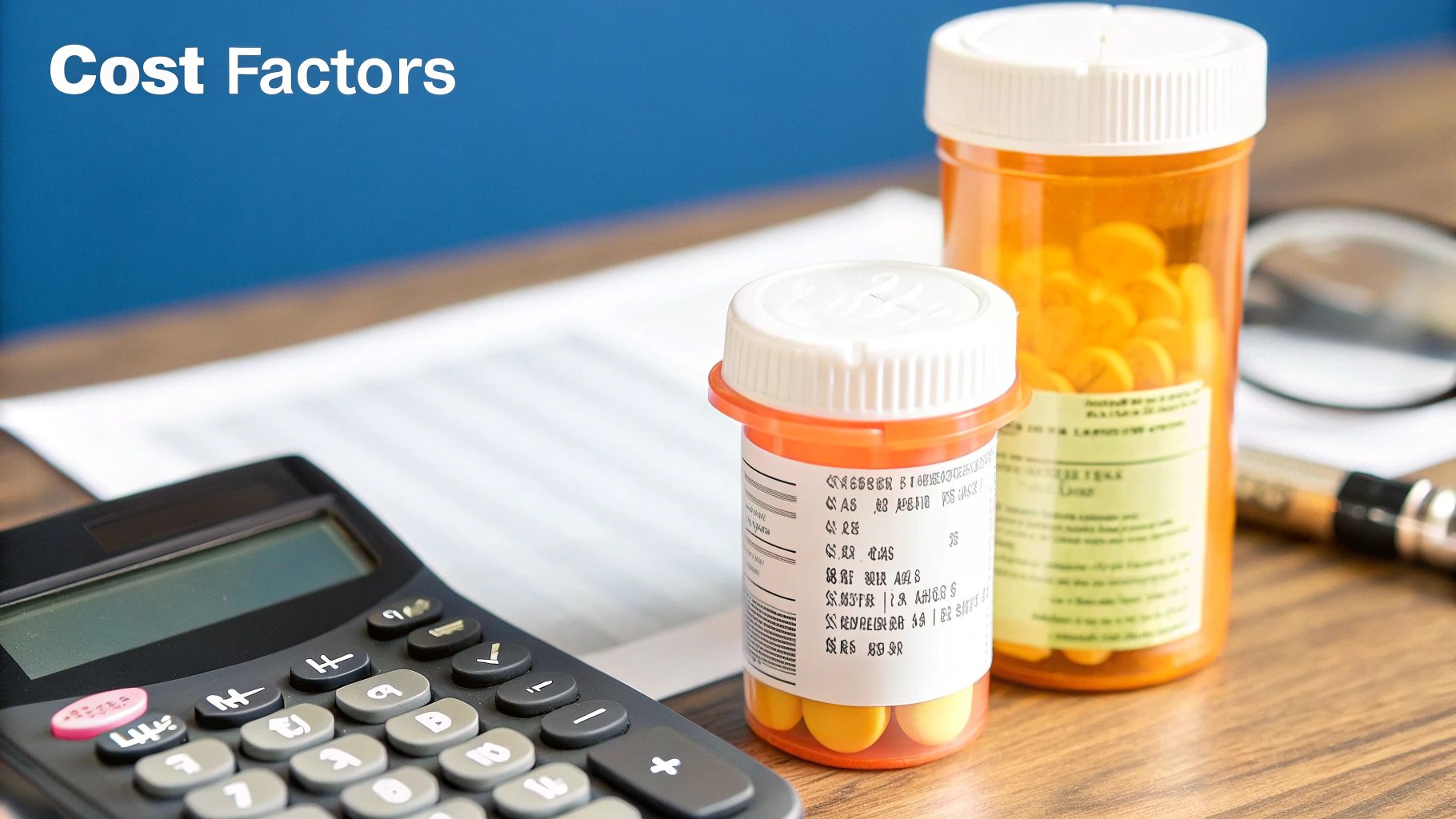
Think of your TRT plan less like a single purchase and more like a subscription to a high-touch service. You're not just buying medication. You’re paying for the entire system of medical oversight, diagnostics, and personalized care that makes the therapy work safely and effectively.
Let's break down the typical charges you'll see on that invoice.
The Consultation Fees
Your journey always starts with a medical consultation, and this first meeting is usually the most expensive one. The initial consultation is a deep dive—a comprehensive look into your health history, current symptoms, and what you want to achieve. It’s more in-depth and naturally costs more than your later check-ins.
Routine follow-up appointments are shorter and less costly. These are essentially progress checks to monitor how you’re doing, fine-tune your dosage, and make sure you aren’t running into any side effects. Their main purpose is maintenance, not a full-blown diagnosis.
The Lab Work and Diagnostics
Before any doctor prescribes testosterone, they have to confirm a clinical need with blood work. This isn't just a simple testosterone test; it’s a full diagnostic panel.
- Initial Diagnostic Labs: This is a broad-spectrum panel that measures your total and free testosterone, estradiol (E2), a complete blood count (CBC), and often other markers like a comprehensive metabolic panel (CMP). This complete picture is essential for a safe and accurate diagnosis.
- Ongoing Monitoring Labs: Once you’re on TRT, you'll need regular, though less extensive, lab work every few months. These tests keep an eye on your testosterone and estradiol levels to ensure they stay in the optimal range. This ongoing monitoring is a non-negotiable part of safe, long-term therapy.
Understanding your bill isn't just about the numbers—it's about seeing the value in each step. Those initial labs protect you by confirming a diagnosis, while the follow-up tests ensure your protocol stays safe and effective over time.
The Medication and Clinic Fees
The most consistent charge on your bill will be for the testosterone itself. The price here is heavily influenced by the delivery method you choose. Injections, gels, and pellets all come with very different price tags, which we’ll get into in the next section.
Finally, many clinics, especially online providers, run on a membership or subscription model. This fee often bundles several services together, which can simplify things greatly:
- Clinic or Administrative Fees: This might cover the cost of your consultations, ongoing patient support, and handling your prescriptions.
- Shipping and Supplies: Some all-inclusive plans will also wrap in the cost of syringes, needles, and discreet shipping right to your door.
By seeing how each of these components contributes to the average cost of testosterone replacement therapy, you can start asking smarter questions. Always ask your provider for an itemized breakdown so you know exactly where every dollar is going. This transparency empowers you to spot any hidden fees and have productive conversations about making your treatment more affordable.
How Your Medication Choice Shapes Your Budget
When you're trying to figure out the real cost of testosterone replacement therapy, the single biggest variable is the medication itself. The way you get testosterone into your body—what we call the delivery method—directly shapes both your monthly bill and your daily routine. It's a lot like choosing a car: a reliable sedan, a convenient SUV, and a high-performance sports car all get you where you need to go, but their price tags and the experience of driving them are worlds apart.
The same idea applies to TRT. The global market for these treatments hit around USD 1.5 billion in 2023 and is still climbing. This is partly because hypogonadism is being diagnosed more often, affecting roughly 1 in 4 men over 30 in the U.S. alone. This growing demand means there are now various delivery methods available, each with its own cost. You can learn more about the TRT market growth and what's driving it. The good news is, this gives you options to find what works for your lifestyle and your wallet.
H3: Injections The Most Budget-Friendly Route
Testosterone injections, like cypionate or enanthate, are hands-down the most common and cost-effective way to go. Usually given once or twice a week, they offer a powerful and reliable method for restoring your hormone levels without emptying your bank account.
The thought of self-injecting can be a bit intimidating at first, but most guys find it quickly becomes a simple, no-fuss part of their weekly routine. The trade-off for the low cost is this hands-on approach and the potential for slight "peaks and valleys" in your testosterone levels between doses.
H3: Gels, Creams, and Patches Daily Convenience at a Premium
For men who would rather skip needles altogether, transdermal options like gels, creams, and patches are a convenient alternative. You apply them to your skin daily, which provides a steady, continuous release of testosterone throughout the day. This often leads to more stable hormone levels compared to weekly injections.
This convenience, however, comes with a much higher price tag. Patches and brand-name gels are often the most expensive forms of TRT, sometimes running several hundred dollars a month if you're paying out-of-pocket. They also demand careful application to make sure the testosterone isn't accidentally transferred to a partner or child.
Key Takeaway: Your medication choice is a balancing act between cost, convenience, and your personal lifestyle. Injections are the most economical, while transdermals provide needle-free ease at a higher price.
To give you a clearer picture, I've put together a table comparing the most popular TRT medications. This will help you weigh the pros, cons, and costs of each option side-by-side.
TRT Medication Cost and Feature Comparison
| Medication Type | Average Monthly Cost | Pros | Cons |
|---|---|---|---|
| Injections | $40 – $100 | Most cost-effective; highly effective; infrequent application (weekly/bi-weekly). | Requires self-injection; potential for hormone level fluctuations between doses. |
| Gels/Creams | $100 – $500+ | Needle-free; provides stable daily hormone levels; easy to apply. | High cost; risk of transference to others; requires daily application. |
| Patches | $200 – $600+ | Needle-free; convenient; steady hormone release. | Can cause skin irritation; may not adhere well; very expensive. |
| Pellets | $400 – $1,000+ (per procedure) | "Set it and forget it" convenience; lasts 3-6 months; no daily or weekly tasks. | High upfront cost; requires a minor in-office procedure for insertion/removal. |
As you can see, the right choice really depends on what you value most—be it saving money, avoiding needles, or minimizing daily effort.
The infographic below also gives a great visual summary of how the monthly costs stack up against each other.
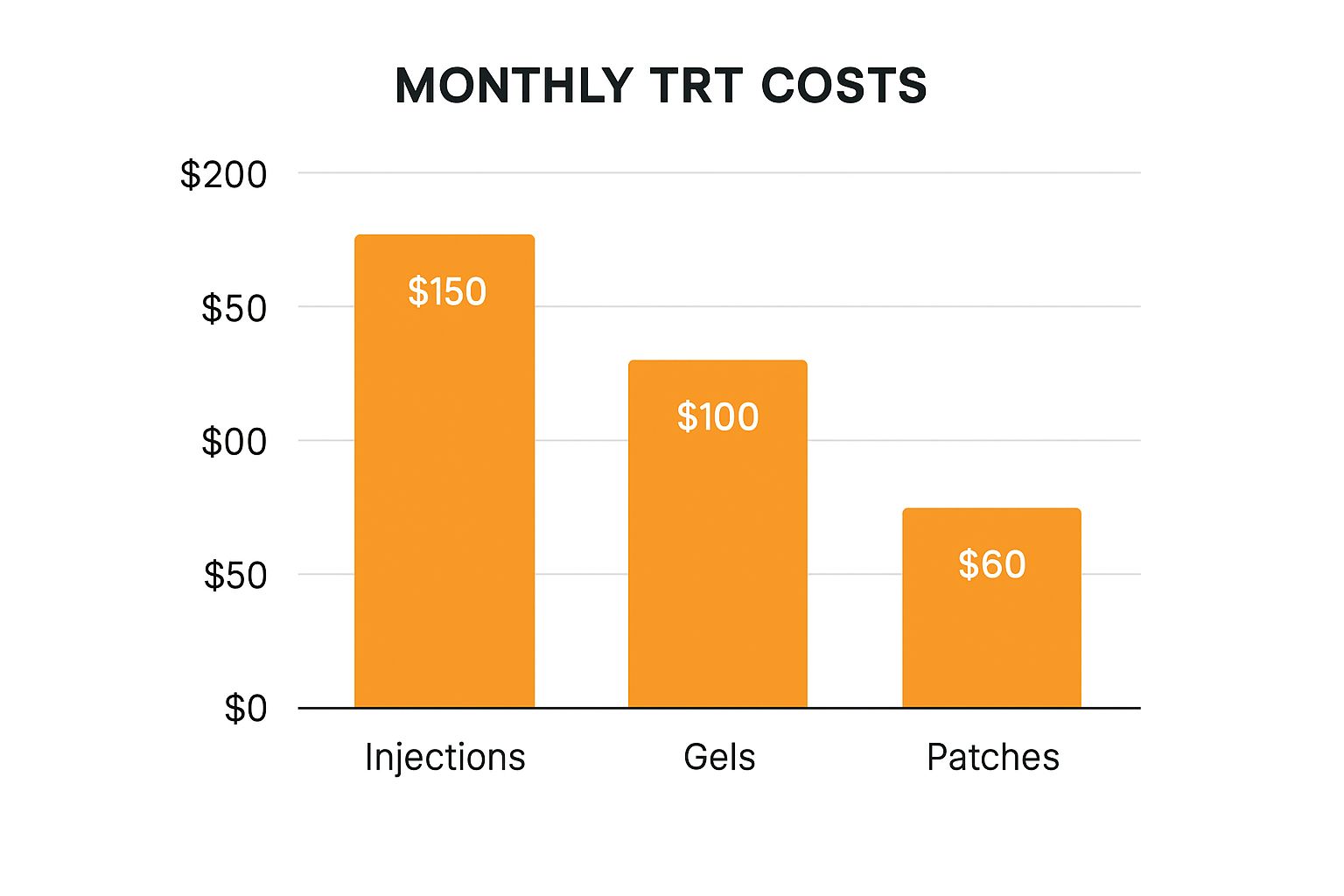
It’s pretty clear from the chart that injections are the most affordable path, while the convenience of transdermal methods comes at a premium.
H3: Pellets The Long-Term Investment
Testosterone pellets offer a unique "set it and forget it" solution. This involves a minor in-office procedure where tiny pellets are implanted just under the skin of your hip or buttock. From there, they slowly release testosterone over 3 to 6 months.
The upfront cost for a pellet procedure is steep—often $1,000 or more—making it the most expensive initial option. But when you average that cost out over its lifespan, the monthly expense can actually be quite competitive with other methods. This is especially true when you factor in the incredible convenience of not having to think about daily or weekly applications. It’s a fantastic choice for men who value convenience above all else and want to keep their day-to-day involvement with therapy to a minimum.
Getting Insurance To Help Cover TRT Costs

Trying to get your health insurance to pay for testosterone replacement therapy can feel like you're navigating a maze blindfolded. It's frustrating. The key to cracking the code is realizing that insurance companies run on strict, evidence-based rules. They don't make decisions based on how you feel; they need undeniable, black-and-white proof that TRT is a medical necessity for you.
Before they'll even consider it, you need a formal diagnosis of clinical hypogonadism. This isn't just about feeling sluggish or having a lower sex drive. It's a medical condition that requires concrete documentation showing your body simply isn't making enough testosterone on its own.
The Two Pillars Of Insurance Approval
Insurers almost universally demand two specific pieces of evidence. Think of these as non-negotiable requirements. If you're missing either one, your claim is almost guaranteed to be denied right out of the gate.
- Lab-Confirmed Low Testosterone: Your doctor will need to show results from at least two separate blood tests. These are usually taken first thing in the morning when your testosterone levels are naturally at their peak. Most insurance plans have a very firm cutoff, often requiring your levels to be below 300 ng/dL. Even a result that's barely over the line, like 305 ng/dL, can be enough to trigger a rejection.
- Documented Symptoms: You must have a clear, recorded history of the classic symptoms of hypogonadism. We're talking about things like chronic fatigue, erectile dysfunction, noticeable loss of muscle mass, or significant mood swings. Your doctor’s notes must explicitly link these symptoms to your low T diagnosis.
Key Insight: Insurance providers don't view TRT as a "lifestyle" or "wellness" treatment. To them, it's a therapy for a documented medical condition. Framing your case through this clinical lens is absolutely essential for getting approved.
Understanding Your Out-of-Pocket Costs
Even if your insurance does approve your TRT, you won't be completely off the hook. Your final out-of-pocket expenses are dictated by the structure of your specific plan, which boils down to three main components:
- Deductible: This is the full amount you have to pay for your covered medical services before your insurance company starts chipping in. If your plan has a $2,000 deductible, you're on the hook for the first $2,000 of your TRT costs.
- Co-pay: After you've hit your deductible, you'll likely have a co-pay. This is a fixed amount you pay for each service, like a $40 fee for every doctor's visit or prescription refill.
- Co-insurance: This is the percentage of the bill you're responsible for after meeting your deductible. If your plan includes 20% co-insurance, you pay 20% of the cost, and your insurer handles the other 80%.
This entire process of lab work and symptom documentation is a critical part of a larger safety protocol. To learn more, check out our guide on why monitoring your TRT is so important for long-term health. Understanding these requirements not only gives you a better shot with insurance but also ensures your therapy is being managed safely and effectively.
Online TRT Clinics Versus Local Doctors
Choosing where to get your TRT is a big decision, and it really comes down to two main paths: a modern online clinic or a traditional local doctor's office. This choice will shape not just your budget but your entire experience. It’s not simply about convenience; you’re comparing two fundamentally different ways of delivering healthcare, and each one fits different needs and personalities.
https://www.youtube.com/embed/6vyXepzddp8
Think of a local doctor's office like a traditional pay-as-you-go service. You pay for each part of the process separately—a fee for the office visit, another charge for the lab work order, and then a separate bill from the pharmacy for your testosterone. This à la carte model feels familiar, but it can also lead to unpredictable costs since every piece is billed on its own.
Online TRT clinics, on the other hand, have flipped the script. They typically operate on a subscription model, bundling everything—your consultations, medication, supplies, and ongoing check-ins—into a single, recurring monthly fee. The idea is to make the average cost of testosterone replacement therapy predictable and easy to manage, so you know exactly what to expect.
Convenience and Access
Let’s be honest, the biggest draw for online clinics is the sheer convenience. You can have consultations from your living room, get your blood drawn at a nearby lab, and have your medication shipped right to your door. No more driving to appointments, sitting in waiting rooms, or taking time off work. It just fits into your life.
This shift to remote care has been a game-changer. Telemedicine and remote monitoring, which really took off during the COVID-19 pandemic, have made it incredibly easy for men to access and manage their TRT. This convenience is a huge factor in the market's growth, which is expected to hit USD 2.28 billion by 2029. You can dig into more of the numbers on the growth of the testosterone therapy market to see just how significant this trend is.
Of course, there’s still a strong case for the local doctor. Nothing beats an in-person physical exam and a long-standing relationship with a physician you trust. For men who prefer that face-to-face interaction or have complex health issues that need a hands-on assessment, the traditional route often feels more thorough and comfortable.
Key Consideration: Your choice boils down to what you prioritize. Online clinics offer predictable, subscription-based pricing and unmatched convenience. Local doctors provide a traditional, hands-on approach with separate billing for each service.
Personalization and Care Models
A common concern with online platforms is whether you'll get "cookie-cutter" treatment. It's a valid question. However, the best online clinics base their entire approach on comprehensive lab work and detailed health histories to create a truly tailored plan. The big advantage here is that you're working with doctors who live and breathe hormone optimization—it's their specialty.
With your local primary care doctor, expertise in TRT can be a bit of a mixed bag. Some are incredibly knowledgeable, but others may not specialize in hormone health, which could lead to a less-than-optimal treatment plan. You could see a local specialist, like a urologist or endocrinologist, to close that knowledge gap, but that often means longer wait times for appointments and higher consultation fees.
Ultimately, there’s no single "best" choice for everyone. It's all about finding the care model that lines up with your personal needs, your budget, and how you want to manage your health.
Smart Strategies to Lower Your TRT Expenses
Feeling the financial weight of ongoing treatment is a common story, but you have more control over the average cost of testosterone replacement therapy than you might think. With a proactive approach, you can find significant savings without ever compromising on the quality of your care. It's really about making smart, informed decisions that line up your health needs with your financial reality.
Taking control starts with a simple, direct conversation with your provider. Don't be shy about discussing costs. A good doctor gets it—for a treatment plan to be successful, it has to be sustainable for you in the long run.
Optimize Your Medication Choices
Your single biggest opportunity for savings is almost always in the medication itself. While convenient, those brand-name gels and patches often come with a premium price tag that can really add up over time.
- Request Generic Options: Always, always ask if a generic version is available. Testosterone cypionate, the most common injectable form, is the perfect example of a highly effective and budget-friendly generic that gets the job done just as well.
- Discuss Long-Acting Treatments: If frequent co-pays for medication refills and trips to the clinic are nickle-and-diming you, it’s worth asking your doctor about longer-acting options. Pellets, for instance, have a higher upfront cost, but they can sometimes work out to be more economical over several months compared to daily gels or weekly shots.
Leverage Discounts and Insurance Benefits
Think of your insurance plan and other discount programs as tools just waiting to be used. A little bit of homework here can lead to substantial savings on your recurring monthly or quarterly expenses.
For example, a quick search for a prescription discount card can often slash the out-of-pocket price of your medication right at the pharmacy counter. And if you have insurance, always double-check that your clinic and preferred lab are in-network to steer clear of those dreaded surprise bills.
The TRT market is expanding rapidly, with projections showing it will grow by USD 461 million between 2025 and 2029, driven by better diagnostics and greater awareness. This growth increases the availability of both affordable generics and expensive branded options, making it crucial for patients to actively seek out cost-effective solutions. You can discover more insights about these market trends to better understand the pricing landscape.
Explore Bundled Service Packages
Many clinics, especially the online providers, now offer bundled packages or monthly membership plans. These plans often roll the cost of consultations, follow-up lab work, and medication into one predictable monthly fee. For many guys, this approach can be far more affordable than paying for each service à la carte.
By combining these strategies, you can build a treatment plan that supports both your health and your wallet. It's also important to remember that while TRT is a powerful medical tool, it works best alongside a healthy lifestyle. Before starting therapy, some men explore ways to support their body's own hormone production first. If you're interested, you can check out our guide on how to increase testosterone naturally for foundational tips.
Your Questions About TRT Costs, Answered
Working out the financial side of Testosterone Replacement Therapy can feel like navigating a maze. Once you get past the headline numbers, a lot of smaller questions about payments, surprise fees, and how your costs might change down the road can pop up. Let’s tackle some of the most common ones head-on so you can get some real clarity.
Getting straight answers to these questions before you start is the best way to budget effectively and sidestep any unexpected bills. It just makes the whole process smoother and less stressful.
Can I Use My HSA Or FSA For TRT?
Yes, you almost certainly can. Using a Health Savings Account (HSA) or a Flexible Spending Account (FSA) to cover your TRT expenses is a smart move. These accounts are designed for exactly this purpose—letting you pay for qualified medical expenses with pre-tax money.
For TRT, this typically includes:
- Doctor consultations and follow-up visits
- Prescribed medications, including testosterone
- All required lab work and diagnostic tests
This can make a real dent in your out-of-pocket costs, effectively giving you a discount on your therapy. Still, it's always a good idea to give your plan administrator a quick call just to confirm that every part of your TRT plan is covered. Don't assume; verify.
Key Takeaway: Tapping into your HSA or FSA is a savvy financial strategy to make TRT more affordable. Just be sure to double-check the specifics with your plan provider before you start swiping that card.
What Hidden Costs Should I Watch For?
While any clinic worth its salt will be upfront about pricing, some "hidden" costs can sneak up on you if you don't know what to ask. You need to be on the lookout for charges that aren't rolled into the main monthly fee.
Think about things like shipping and handling fees for your medication, extra charges for specialized lab tests that go beyond a routine panel, or the cost of ancillary medications. For instance, you might need an aromatase inhibitor to manage potential side effects, and that might be a separate line item. The best defense here is a good offense: ask for a complete, itemized cost breakdown before you commit to anything.
Does The Cost Of TRT Change Over Time?
Absolutely. In fact, it's almost guaranteed that the cost of TRT will shift a bit over time. Your initial investment will almost always be the highest. This is because the upfront phase includes a comprehensive consultation and an extensive first round of lab work to get a precise diagnosis and establish your baseline.
Once you’re past that initial setup, your costs usually settle into a more predictable rhythm for your medication and routine monitoring. But even then, things can change. Your expenses might fluctuate due to medication price increases, shifts in your insurance coverage, or if your doctor decides to adjust your protocol. A new protocol could mean different drugs or more frequent lab tests to make sure everything is working safely and effectively for your long-term health.
At Elite Bioscience, we're built on a foundation of complete transparency and truly personalized care. Our team is here to walk you through every step, making sure your treatment plan is not only effective but also sustainable for your budget and lifestyle. Ready to feel your best?
Start your confidential online health assessment with Elite Bioscience today.
